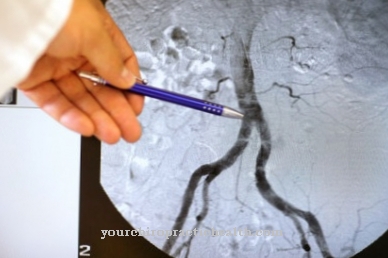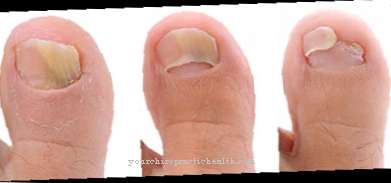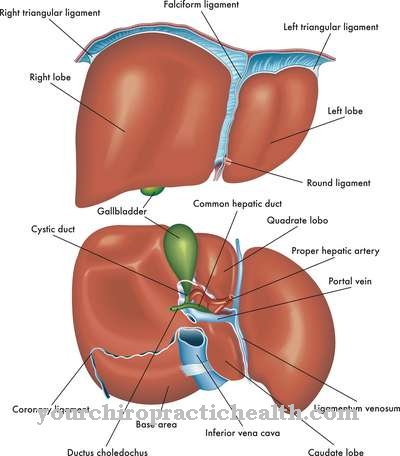As acute intermittent porphyria is a sub-form of porphyria. In this inherited disease, the organism is not able to correctly produce the blood pigment heme.
What is Acute Intermittent Porphyria?

Acute intermittent porphyria (AIP) represents one of a total of four acute forms of porphyria. The other three types are named hereditary coproporphyria, Porphyria variegata and Doss porphyria.
They all have in common that they suddenly experience abdominal pain that sometimes lasts for a few days. Acute intermittent porphyria, which is the most common form, is of particular medical relevance. It shows up primarily in women.
causes
Porphyrias such as acute intermittent porphyria are little known because they occur very rarely. The related metabolic diseases usually affect the nervous system and skin. As with the other porphyrias, the production of the protein-containing blood pigment heme is also disturbed in acute intermittent porphyria.
This process causes heme precursors, so-called porphyrins, to accumulate in the body and cause discomfort. Heme is a component of hemoglobin, the red blood pigment. The body needs special enzymes to produce the heme.
In the case of porphyria, however, at least one enzyme is defective, which in turn has a negative effect on the production of the heme. The acute intermittent porphyria is caused by a defect in the third enzyme in the heme synthesis pathway, which leads to the discontinuation of production. An autosomal dominant genetic defect in the porphobilinogen deaminase is responsible for the porphyria.
Autosomal dominant means independent of the sex chromosomes. Symptoms of acute intermittent porphyria, however, only arise in connection with infections, the influence of alcohol or the use of medication. This leads to the triggering of an acute episode of illness. In most cases, acute intermittent porphyria appears between the ages of 20 and 40.
The most common triggers of the disease are drugs such as sulfonamides, barbiturates or estrogens contained in the birth control pill, as well as alcohol, tobacco consumption, psychological stress and physical stress from infections or surgical interventions. Other reasons can be increased iron levels, menstruation and hunger from fasting or dieting.
You can find your medication here
➔ Medicines for muscle weaknessSymptoms, ailments & signs
Acute intermittent porphyria has many different symptoms, making it difficult to diagnose. In around 90 percent of all patients, however, there are no symptoms at all, while in other cases they are so pronounced that they even lead to paralysis. The main complaints of acute intermittent porphyria are acute abdominal pain.
Neurological and psychiatric symptoms are also not uncommon. The symptoms show up in episodes that last one to two weeks. Sometimes, however, a longer complaint period is also possible. In addition to severe colicky abdominal pain in the lower abdomen, those affected suffer from chronic constipation, vomiting, fever, and partial or complete paralysis.
Sensory disturbances in smelling, hearing, sight and taste as well as high blood pressure and a racing heart. Another feature is the reddish urine, which darkens as it progresses. Dark spots appear on the underwear. Psychological symptoms such as mood swings, confusion or delusions are also conceivable.
Diagnosis & course
Diagnosing acute intermittent porphyria can be difficult, even for experienced medical professionals. The typical symptoms of porphyry are considered to be an important feature. The patient's medical history can also be helpful if relatives have already had similar symptoms. In order to be able to make an exact diagnosis, the doctor takes urine, stool and blood samples.
These are examined for porphyrins in a laboratory. An examination should then be carried out if the patient is suffering from symptoms because the values may decrease as the disease progresses. If the urine is left to stand for a long time in acute intermittent porphyria, it takes on a red to dark red color in two thirds of all patients.
The reverse Ehrlich aldehyde test can be used as a further test, in which a drop of urine is placed in one milliliter of Ehrlich reagent. In the case of acute intermittent porphyria, a cherry-red discoloration occurs. In most cases, the course of AIP is favorable, provided that appropriate therapy takes place. Occasionally, however, there are complications such as shortness of breath, a lack of fluids and damage to the liver and kidneys.
Complications
Acute intermittent porphyria is a rare disease that affects women more than men. The temporary symptom swells latently in the body until a certain factor brings it to light. A genetic enzyme defect is thought to be responsible for the occurrence of porphyria as the pathogenesis.
It does not appear in every person affected who is predisposed to this symptom. The first flare-ups break out as a young adult. The outbreaks are unpredictable and cause the patient considerable and sometimes life-limiting complications.
External influences such as stress, medication, alcohol, the menstrual cycle, infections, nicotine and extreme diets are considered to be trigger factors. The range of symptoms of the outbreaks is variable and includes nausea, colic, circulatory problems, urine discoloration, neurological disorders, as well as psychological changes and hallucinations.
If symptoms are misinterpreted or treated incorrectly, further complications can arise and the flare-ups can worsen. Sometimes there is a risk of life-threatening respiratory paralysis. Furthermore, those affected tend to develop liver cancer and kidney damage as secondary complications.
Misdiagnoses can occur due to the variety of triggers and their accompanying symptoms. Therefore, a thorough medical history in the intensive care unit is recommended. The symptom is incurable. Strategies are developed to find triggers that the patient learns to bypass.
When should you go to the doctor?
If acute gastrointestinal complaints, cardiovascular complaints and sensory disorders occur again and again, you should see a doctor immediately if possible. The doctor can use the symptoms and some stool or urine samples to determine whether it is acute intermittent porphyria. The diagnosis is made easier by talking to the patient. If the symptoms have been showing for longer than one to two weeks, this at least indicates a serious illness that must be monitored.
Increasing symptoms such as chronic constipation, vomiting, fever or paralysis as well as problems with sight, smell, taste and hearing are clear warning signs for acute intermittent porphyria. If the disease is diagnosed on the basis of these symptoms, treatment must always be given.
A visit to the doctor is recommended at the latest in the event of physical failure and a marked decrease in well-being. People who are regularly under stress, take medication, nicotine or alcohol, or follow an extreme diet should see a doctor immediately if the disease breaks out.
Doctors & therapists in your area
Treatment & Therapy
Since acute intermittent porphyria is a genetic defect, the disease cannot be cured. For this reason, symptomatic treatment is carried out to relieve the discomfort. In addition, the triggering factors should be avoided.
If the AIP relapses are severe, intensive care in a hospital may be required. So there is a risk of respiratory paralysis. If certain drugs are responsible for the flare-up, they must be discontinued. The patient also receives heme arginine or glucose via an infusion.
In this way, enriched heme precursors can be excreted from the organism. Morphine derivatives and acetylsalicylic acid can be administered to treat the pain. Reserpine and beta blockers are effective remedies for palpitations. In addition, the patient must refrain from alcohol. If there are causative infections, these must be treated.
You can find your medication here
➔ Medicines for muscle weaknessprevention
Unfortunately, it is not possible to prevent acute intermittent porphyria because it is a genetic defect. However, there is an option to counteract the flare-ups by avoiding tobacco, alcohol, strong sunlight and stress.
You can do that yourself
In this form of porphyria, the symptoms can be so severe that they not only burden the patient physically but also mentally. In addition, there are often neurological complaints. Both of these factors make accompanying psychotherapeutic treatment advisable.
As with all forms of porphyria, all triggers that could trigger another flare-up should be avoided. Therefore, the patient with acute intermittent porphyria should not drink alcohol and avoid certain medications. The attending physician will determine which medication these are in detail after consultation. Those affected can also find a drug information sheet for acute porphyrias on the self-help page of EPP Germany (www.epp-deutschland.de).
Nicotine must be taboo and a patient with acute intermittent porphyria should avoid stressful situations as much as possible. Instead, he should pay attention to a regular daily rhythm, get enough sleep and move as much as possible. Relaxation exercises such as Reiki, Yoga or Jacobson's progressive muscle relaxation help to reduce daily stress.
Extreme diets are also unnecessary stress. A balanced, healthy diet that consists of fresh foods such as fruit and vegetables and contains as little fat and sugar as possible is more advisable. This diet also strengthens the immune system, which is helpful in fighting infections. This is all the more important when you consider that infections are one of the triggers of acute intermittent porphyria.












.jpg)



.jpg)










.jpg)
